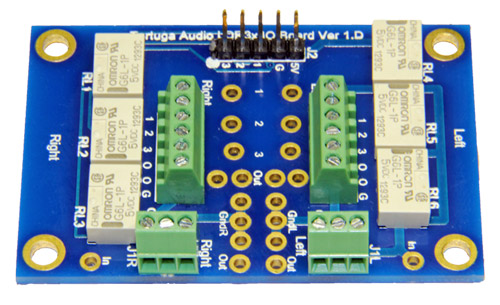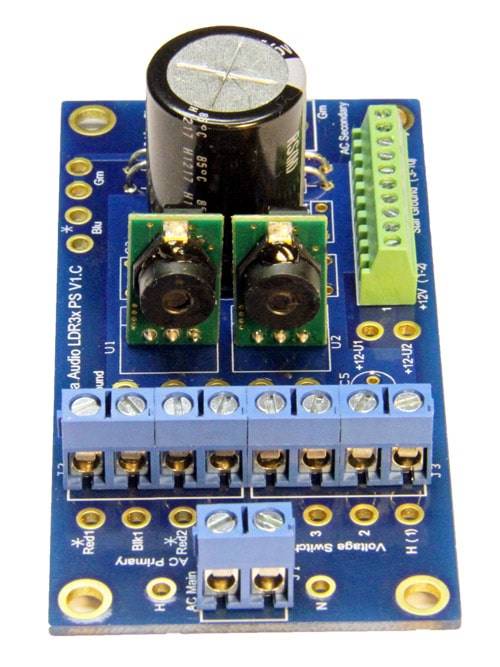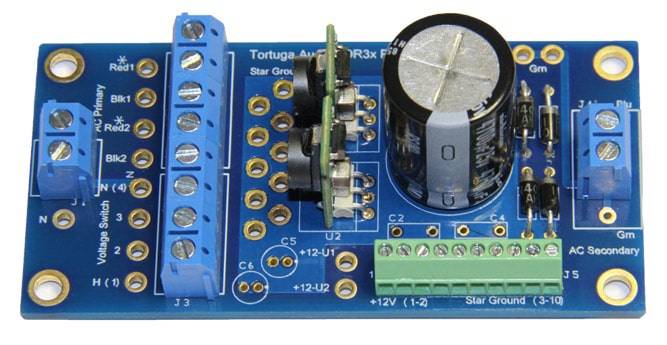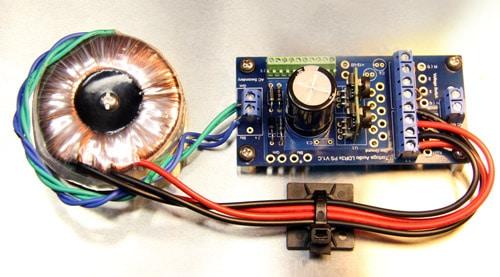Taking Pre-Orders for Input Relay Board
We are pleased to announce that we are now taking pre-orders for the new IO Relay Board. 😀
We expect to be shipping the IO Board on or before April 7th barring any glitches with our suppliers.
The IO Board price is $59 which includes the power/control connectors between the board and the LDR3x Preamp Controller Board.
It will work with both versions 1 & 2 of the LDR3x Preamp Controller Board or any other preamp control device that provides +5V and switching to ground.
You can find more info and pre-order the board here: IO Relay Board | Tortuga Audio

We are pleased to announce that we are now taking pre-orders for the new IO Relay Board. 😀
We expect to be shipping the IO Board on or before April 7th barring any glitches with our suppliers.
The IO Board price is $59 which includes the power/control connectors between the board and the LDR3x Preamp Controller Board.
It will work with both versions 1 & 2 of the LDR3x Preamp Controller Board or any other preamp control device that provides +5V and switching to ground.
You can find more info and pre-order the board here: IO Relay Board | Tortuga Audio

Hi Morten,
I would like to apologize for my earlier comments on this board - I regret the tone of my posts, and I'm sure the issue could have been handled better. Again, sincere apologies.
I would like to apologize for my earlier comments on this board - I regret the tone of my posts, and I'm sure the issue could have been handled better. Again, sincere apologies.
Hi Morten,
I would like to apologize for my earlier comments on this board - I regret the tone of my posts, and I'm sure the issue could have been handled better. Again, sincere apologies.
Thanks. Much appreciated. No worries. 😀
Are Tortuga Audio Preamps Passive or Not?
Found an interesting thread on Audio Asylum regarding Tortuga Audio. What got my attention were the comments on whether our LDRx passive preamps are indeed true passives or actually actives....or perhaps some type of hybrid.
Here's the link: Audio Asylum Thread Printer
The answer may depend on one's definition of either term but I think the arguments for either distill down into something like this...
It's a passive preamp because:
1) There's no gain (no amplification of the audio signal)
2) All the audio signal sees is a variable resistor (LDRs)
3) Although it has a power supply, the power is used solely to control the variable resistor (LDRs) which is optically isolated from the audio signal.
4) There's no buffer stage (high impedance in, low impedance out)
It's an active preamp because:
1) It uses a power supply, the power controls the LDR light source, the light source modulates the variable resistor, the variable resistance influences the audio signal, thus the audio signal does indeed "see" the power supply, therefore it's active.
2) If an improved dc voltage regulator can improve the preamp's sound quality, how is that not an active device?
It's a hybrid because:
1) It has characteristics of both a passive and active device without being classically either.
To be clear, I'm not taking a firm position on either end of the argument because in my view these are all valid observations and characterizations. That said, if we consider a continuum of 1-10 with 1 being pure passive and 10 being unequivocally active, I would submit the LDRx preamps are somewhere in the 2-4 range; a hybrid but more passive than active.
Found an interesting thread on Audio Asylum regarding Tortuga Audio. What got my attention were the comments on whether our LDRx passive preamps are indeed true passives or actually actives....or perhaps some type of hybrid.
Here's the link: Audio Asylum Thread Printer
The answer may depend on one's definition of either term but I think the arguments for either distill down into something like this...
It's a passive preamp because:
1) There's no gain (no amplification of the audio signal)
2) All the audio signal sees is a variable resistor (LDRs)
3) Although it has a power supply, the power is used solely to control the variable resistor (LDRs) which is optically isolated from the audio signal.
4) There's no buffer stage (high impedance in, low impedance out)
It's an active preamp because:
1) It uses a power supply, the power controls the LDR light source, the light source modulates the variable resistor, the variable resistance influences the audio signal, thus the audio signal does indeed "see" the power supply, therefore it's active.
2) If an improved dc voltage regulator can improve the preamp's sound quality, how is that not an active device?
It's a hybrid because:
1) It has characteristics of both a passive and active device without being classically either.
To be clear, I'm not taking a firm position on either end of the argument because in my view these are all valid observations and characterizations. That said, if we consider a continuum of 1-10 with 1 being pure passive and 10 being unequivocally active, I would submit the LDRx preamps are somewhere in the 2-4 range; a hybrid but more passive than active.
Some other observations regarding the use of LDRs:
1. Despite eveyone characterizing them as variable resistors, they are semiconductors. The material between the two conductive components is made of doped silicon or germanium, same as any transistor.
2. While there is no gain, many "active" devices also exhibit gains of <1 (cathode follower, op-amp with inverting output, etc.).
3. Since the LDR is a semiconductor device whose resistance varies with an external control which is electrically isolated from the signal, it would seem to behave more like an active MOSFET device than a passive resistor.
4. If a MOSFET were used as a varible resistor in this fashion, all of the statements you made regarding passive preamps (1-4) are still true.
I'd submit the LDRx preamps are somewhere in the 6-8 range; a hybrid but more active than passive.
1. Despite eveyone characterizing them as variable resistors, they are semiconductors. The material between the two conductive components is made of doped silicon or germanium, same as any transistor.
2. While there is no gain, many "active" devices also exhibit gains of <1 (cathode follower, op-amp with inverting output, etc.).
3. Since the LDR is a semiconductor device whose resistance varies with an external control which is electrically isolated from the signal, it would seem to behave more like an active MOSFET device than a passive resistor.
4. If a MOSFET were used as a varible resistor in this fashion, all of the statements you made regarding passive preamps (1-4) are still true.
I'd submit the LDRx preamps are somewhere in the 6-8 range; a hybrid but more active than passive.
IO3 Relay Board
Here's build #1 of our new IO3 Relay Board.
Officially released as of 4.5.14 (2 days early! ) 😀
Everything including grounds can be connected either via screw terminal blocks or solder pads.
Interfaces with the LDR3x which provides +5 VDC power & control
$59 - includes interface cabling etc. to the LDR3x
More info here: IO3 Relay Board | Tortuga Audio

Here's build #1 of our new IO3 Relay Board.
Officially released as of 4.5.14 (2 days early! ) 😀
Everything including grounds can be connected either via screw terminal blocks or solder pads.
Interfaces with the LDR3x which provides +5 VDC power & control
$59 - includes interface cabling etc. to the LDR3x
More info here: IO3 Relay Board | Tortuga Audio

Can the switching of inputs be controlled via remote?
When interfaced with an LDR3x Preamp Controller/Attenuator yes it can. Both via remote and also manually via a rotary encoder. We are presently sold out of the original LDR3x but are coming out soon with a version 2.
The Poll At The Top of the Page
If you're reading this please take a moment and answer the poll at the top of this page. I value your input. 😉
Thanks!😀
Morten
If you're reading this please take a moment and answer the poll at the top of this page. I value your input. 😉
Thanks!😀
Morten
Gotta say an phone app would be awesome.
Not sure if that's a generational thing or not
I would argue that it is. If you grew up with the evolution of the classic dedicated handheld remote, it feels familiar. If you grew up with smart phones & apps....just get the app...already have the handheld.
New switich mode regulated power supply
Fresh pics of the new 12/5 VDC LDR3x power supply that uses switch mode dc-dc power regulators and a 10VA toroidal transformer. Comes in a few variations including:
1) 12 V - 400ma - single regulator
2) 12 V - 800ma (or 2 x 400ma) - dual regulators
3) 12 V - 400ma & 5 V - 4000ma - dual regulators
Will have this loaded up and for sale on our website over the next 24 hours or so.




Fresh pics of the new 12/5 VDC LDR3x power supply that uses switch mode dc-dc power regulators and a 10VA toroidal transformer. Comes in a few variations including:
1) 12 V - 400ma - single regulator
2) 12 V - 800ma (or 2 x 400ma) - dual regulators
3) 12 V - 400ma & 5 V - 4000ma - dual regulators
Will have this loaded up and for sale on our website over the next 24 hours or so.




LDRx Passive Preamp Review
Another stellar review by latest participant in our tour over at AudioCircle. 😀
Check out the review here: LDRx Passive Preamp Tour
Another stellar review by latest participant in our tour over at AudioCircle. 😀
Check out the review here: LDRx Passive Preamp Tour
I would argue that it is. If you grew up with the evolution of the classic dedicated handheld remote, it feels familiar. If you grew up with smart phones & apps....just get the app...already have the handheld.
Not sure I agree...I'm in my 60's and only a year into my 1st smartphone & there is no question that an app is superior. I use one for my Squeezebox Touch and haven't picked up the remote since I loaded the app.
Not sure I agree...I'm in my 60's and only a year into my 1st smartphone & there is no question that an app is superior. I use one for my Squeezebox Touch and haven't picked up the remote since I loaded the app.
Having run a couple of polls on this topic suggests that it breaks down as I noted. But I'm with you on this one personally. I juggle remotes every day and frankly find them quite annoying. Apps for me thank you.
Plus for small manufacturers, having a customized high end remote designed and built for your product line is quite expensive unless you order thousands of units. Whereas an app is a bit of up front development cost and then has essentially zero marginal cost.
I agree that wasting time finding the remote that the dog's hidden or whatever is annoying but how is the app going to communicate with the amp? If via wireless then this could potentially introduce RFI or other noise at a critical juncture in the signal path. I'd rather keep that stuff as far from my pre-amp as possible and seeing as my pre is in the same box as my dac that makes it double-y risky. Mobiles/laptops used to have IR transmitters in them but maybe they don't anymore.
I see the advantage from the manufacturers point of view of having an easy to update app as opposed to holding stock of a load of handsets. However, there is still the maintenance of presumably many (well 3 main ones I guess) versions of the app and some level of technical support where many more of the problems are going to be out of your control than they currently are....I can't get my app to recognise my amp...etc etc
I know we're just talking about volume and source selection but I did have some fun in a bar one night when we managed to guess the sonos password and played Rage Against the Machine all night ;-)))
I see the advantage from the manufacturers point of view of having an easy to update app as opposed to holding stock of a load of handsets. However, there is still the maintenance of presumably many (well 3 main ones I guess) versions of the app and some level of technical support where many more of the problems are going to be out of your control than they currently are....I can't get my app to recognise my amp...etc etc
I know we're just talking about volume and source selection but I did have some fun in a bar one night when we managed to guess the sonos password and played Rage Against the Machine all night ;-)))
Pass the remote....er...the app
I don't see wireless being viable (yet) when it comes to noise sensitive audio equipment. Of course that may change in the future. Back when I was in a corporate environment, the ability of smartphones to intrude on telecom and audio equipment was notorious and led to some awkward moments with people scrambling to find and shut down their offending Blackberries, iPhones etc.
While IR transceivers were once fairly common in upscale cellphones, IR disappeared for a while. But, they're back! Or on their way back. Check out this article: Back from the dead: why do 2013's best smartphones have IR blasters? | The Verge
My personal view is there's a growing recognition that as apps and smartphones evolve and become ubiquitous that IR is once again being recognized as the defacto means of controlling most consumer gear like big screen TVs etc. nearly all of which have IR as their primary means of remote control.
As a practical matter, IR doesn't interfere with audio. IR receivers are only active when they're being sent IR signals. And a momentary burst of 38 khz IR is both outside of the audible range, and is....well...just a momentary burst. Implemented correctly, I challenge anyone to demonstrate how a standby IR receiver within a piece of audio gear is buggering up the audio signal.
Meanwhile the app building tools for iPhone/iPad/Android devices are evolving to the point where apps can be compiled for any of these devices from a common development platform rather than specialized separate development tools. This is making both the initial development and the ongoing support of multi-platform apps a whole lot less challenging than even just a few years ago.
Having said all that, I'm still inclined to offer both a physical handheld as will as apps for our preamp products in the future. However, the physical handheld will probably end up being the Apple Remote; a sleek functional remote that retails for around $20 and definitely gets the job done.
I agree that wasting time finding the remote that the dog's hidden or whatever is annoying but how is the app going to communicate with the amp? If via wireless then this could potentially introduce RFI or other noise at a critical juncture in the signal path. I'd rather keep that stuff as far from my pre-amp as possible and seeing as my pre is in the same box as my dac that makes it double-y risky. Mobiles/laptops used to have IR transmitters in them but maybe they don't anymore.
I see the advantage from the manufacturers point of view of having an easy to update app as opposed to holding stock of a load of handsets. However, there is still the maintenance of presumably many (well 3 main ones I guess) versions of the app and some level of technical support where many more of the problems are going to be out of your control than they currently are....I can't get my app to recognise my amp...etc etc
I know we're just talking about volume and source selection but I did have some fun in a bar one night when we managed to guess the sonos password and played Rage Against the Machine all night ;-)))
I don't see wireless being viable (yet) when it comes to noise sensitive audio equipment. Of course that may change in the future. Back when I was in a corporate environment, the ability of smartphones to intrude on telecom and audio equipment was notorious and led to some awkward moments with people scrambling to find and shut down their offending Blackberries, iPhones etc.
While IR transceivers were once fairly common in upscale cellphones, IR disappeared for a while. But, they're back! Or on their way back. Check out this article: Back from the dead: why do 2013's best smartphones have IR blasters? | The Verge
My personal view is there's a growing recognition that as apps and smartphones evolve and become ubiquitous that IR is once again being recognized as the defacto means of controlling most consumer gear like big screen TVs etc. nearly all of which have IR as their primary means of remote control.
As a practical matter, IR doesn't interfere with audio. IR receivers are only active when they're being sent IR signals. And a momentary burst of 38 khz IR is both outside of the audible range, and is....well...just a momentary burst. Implemented correctly, I challenge anyone to demonstrate how a standby IR receiver within a piece of audio gear is buggering up the audio signal.
Meanwhile the app building tools for iPhone/iPad/Android devices are evolving to the point where apps can be compiled for any of these devices from a common development platform rather than specialized separate development tools. This is making both the initial development and the ongoing support of multi-platform apps a whole lot less challenging than even just a few years ago.
Having said all that, I'm still inclined to offer both a physical handheld as will as apps for our preamp products in the future. However, the physical handheld will probably end up being the Apple Remote; a sleek functional remote that retails for around $20 and definitely gets the job done.
Replaceable LDR Module
A preview of our replaceable LDR Module that will be used in our upcoming Version 2 LDR3x Preamp Controller Board. Each LDR3x uses 4 of these. If needed, it's a simple matter of unplugging an LDR Module and popping in a new one in. Not unlike a tube.
In some ways, LDRs and tubes are similar even though they do very different things. Some tubes fail early on. Some tubes drift to the point they become out of spec and need to be replaced. All tubes have finite, albeit long, lives and eventually need to be replaced. Newer, better, and even older/better tubes come along that warrant replacing the original tube for improved performance. LDRs are similar in these respects.
So, introducing the replaceable LDR Module. Boom!
Will we see "LDR Rolling" in the future? Don't know. But it's good to stay flexible. 😀
A preview of our replaceable LDR Module that will be used in our upcoming Version 2 LDR3x Preamp Controller Board. Each LDR3x uses 4 of these. If needed, it's a simple matter of unplugging an LDR Module and popping in a new one in. Not unlike a tube.
In some ways, LDRs and tubes are similar even though they do very different things. Some tubes fail early on. Some tubes drift to the point they become out of spec and need to be replaced. All tubes have finite, albeit long, lives and eventually need to be replaced. Newer, better, and even older/better tubes come along that warrant replacing the original tube for improved performance. LDRs are similar in these respects.
So, introducing the replaceable LDR Module. Boom!
Will we see "LDR Rolling" in the future? Don't know. But it's good to stay flexible. 😀
An externally hosted image should be here but it was not working when we last tested it.
LDR Auto Calibration
While waiting on the LDR3x.V2 production boards to arrive from our fabricator we've been working like mad on tuning up the auto-calibration software.
I can now say without a doubt that auto-calibration has exceeded all expectations with channel balance within +/- 0.1 dB over the full attenuation range of -60 to 0 dB. For LDRs that's darn tight balance and sounds fantastic. And that's hands off with no help from external test/calibration equipment...or matched LDRs!! It's taking roughly 10 minutes to run through a full auto-calibration cycle for all 4 LDRs with each LDR going through 70 attenuation steps.
One decision that's yet to be made is how often to run the auto-calibration routine when the unit is turned off. During development, we've just let it run continuously when off. There's no harm in this as far as the LDRs go but the EEPROM memory we write the results to will eventually fail. Assuming a life of 1,000,000 erase/write cycles this translates into something like 16 years of auto-calibration every 10 minutes. If we put in a timer to only run auto-cal every 60 minutes than the life of the EEPROM becomes something like 97+ years. Good enough, ya think!!? 😀
Of course this also assumes the unit is never turned on....which would be sad indeed. 🙁
Check out this recent article we posted on the evolution of LDR volume control: The Evolution of LDR Volume Control | Tortuga Audio
Cheers,
Morten
While waiting on the LDR3x.V2 production boards to arrive from our fabricator we've been working like mad on tuning up the auto-calibration software.
I can now say without a doubt that auto-calibration has exceeded all expectations with channel balance within +/- 0.1 dB over the full attenuation range of -60 to 0 dB. For LDRs that's darn tight balance and sounds fantastic. And that's hands off with no help from external test/calibration equipment...or matched LDRs!! It's taking roughly 10 minutes to run through a full auto-calibration cycle for all 4 LDRs with each LDR going through 70 attenuation steps.
One decision that's yet to be made is how often to run the auto-calibration routine when the unit is turned off. During development, we've just let it run continuously when off. There's no harm in this as far as the LDRs go but the EEPROM memory we write the results to will eventually fail. Assuming a life of 1,000,000 erase/write cycles this translates into something like 16 years of auto-calibration every 10 minutes. If we put in a timer to only run auto-cal every 60 minutes than the life of the EEPROM becomes something like 97+ years. Good enough, ya think!!? 😀
Of course this also assumes the unit is never turned on....which would be sad indeed. 🙁
Check out this recent article we posted on the evolution of LDR volume control: The Evolution of LDR Volume Control | Tortuga Audio
Cheers,

Morten
- Status
- Not open for further replies.
- Home
- Vendor's Bazaar
- Tortuga Audio LDR3x DIY Preamp Controller w/ Remote